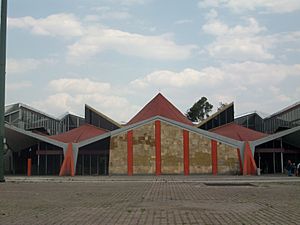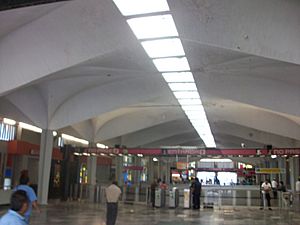Félix Candela facts for kids
Quick facts for kids
Félix Candela Outeriño
|
|
|---|---|
 |
|
| Born | January 27, 1910 Madrid, Spain
|
| Died | December 7, 1997 (aged 87) Durham, North Carolina, United States
|
| Nationality | Spanish, Mexican |
| Education | Madrid School of Architecture |
| Occupation | Engineer |
| Spouse(s) | Eladia Martin |
| Engineering career | |
| Discipline | Architecture |
| Institutions | Institution of Structural Engineers |
| Projects | Ciutat de les Arts i les Ciències, Palacio de los Deportes |
| Significant design | thin shells |
| Awards | IStructE Gold Medal, Augusto Perret prize of the Architects International Union |
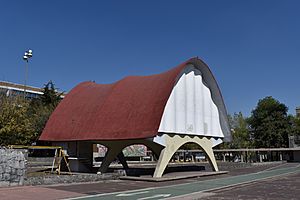
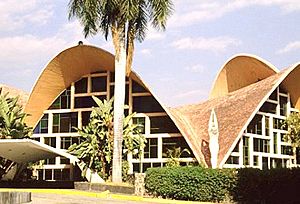
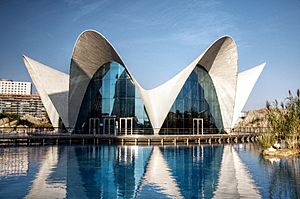
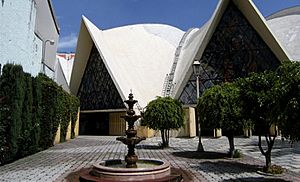
Félix Candela Outeriño (born January 27, 1910 – died December 7, 1997) was a famous Spanish and Mexican architect. He was born in Madrid, Spain. When he was 26, he moved to Mexico and became a citizen of both countries.
Candela is well-known for his important work in Mexican architecture and structural engineering. His biggest contribution was creating special thin-shell structures made from reinforced concrete. These are often called cascarones because they look like thin shells. He also taught Santiago Calatrava, another famous architect, and greatly influenced his designs.
Contents
Early Life and Education
Félix Candela was born in Madrid, Spain, in 1910. In 1927, he started studying at the Superior Technical School of Architecture of Madrid. He graduated in 1935. During his studies, Candela showed a strong understanding of geometry. He even helped other students with private lessons.
His professor, Luis Vegas, noticed his talent in geometry and trigonometry. Vegas made Candela his "helper." While assisting Vegas, Candela entered many architecture contests and won most of them. He wasn't very interested in pure math, but he was great at applying it to building design.
Candela's studies were cut short when the Spanish Civil War began in 1936. He joined the fight and became a Captain of Engineers. After the war, he moved to Mexico in 1939. He arrived in Acapulco and began his career there.
Candela was an expert in paraboloid and hyperbolic geometry. These are special curved shapes. He loved to experiment with these shapes for buildings, especially for roofs and other structures. He saw that these designs could be both artistic and save money.
In Mexico, Candela married Eladia Martin, and they started a family. In his younger years, Félix also enjoyed sports like rugby and skiing.
Designing Thin-Shell Structures
Félix Candela spent his career showing how strong and useful reinforced concrete could be in building design. He found that concrete works best when shaped like a dome or a thin shell. These shapes help the concrete handle forces better, making the structures very efficient.
Candela always tried to solve building problems in the simplest way. For his shell designs, he focused on the natural shapes and properties of the shells. He didn't always rely on super complex math. He was inspired by other engineers like Eduardo Torroja and Guillermo Gonzalez Zuleta.
Around 1950, when his company started designing these thin, curved structures, Candela studied many engineering articles. He realized that the way reinforced concrete behaved was sometimes different from what traditional theories suggested. He often said that analyzing a structure was like a "hobby" to him.
Working in Mexico: 1939-1968
When Félix Candela first arrived in Mexico, he worked as an architect. By 1949, he began to focus on engineering many concrete buildings using his famous thin-shell designs. Most of his major work happened in Mexico during the 1950s and 1960s.
During this time, he was involved in over 300 buildings and 900 projects. The Mexican government gave him many big projects, like the Cosmic Rays Pavilion. In 1956, the Mexican President, Adolfo Ruiz Cortines, increased funding for public works and education. This was good news for Candela, who benefited from the new construction projects and also became a professor.
Candela taught in Mexico for many years. Later, he moved to the United States and taught at the University of Illinois at Chicago from 1971 to 1978.
Teaching in the United States
On September 1, 1971, Candela became a Professor of Architecture at the University of Illinois at Chicago Circle campus (now called University of Illinois at Chicago). He held this position until 1978.
Famous Works
Here are some of the notable buildings Félix Candela designed or helped design:
- 1951: Pabellón de Rayos Cósmicos ("Pavilion of Cosmic Rays") at National Autonomous University of Mexico.
- 1952: Customs warehouses in Pantaco, Azcapotzalco, Mexico City.
- 1953-1957: Iglesia de la Medalla de la Virgen Milagrosa in Colonia Narvarte, Mexico City.
- 1955: Roof for the Mexican Stock Exchange, Mexico City.
- 1955-1956: Municipal markets in Coyoacán, Azcapotzalco, and Anáhuac, Mexico City.
- 1956: Restaurant at the Hotel Casino de la Selva, Cuernavaca, Mexico (this building was later taken down in 2001).
- 1958: Los Manatiales restaurant in Xochimilco, Mexico City.
- 1959-1960: Bacardi bottling plant in Cuautitlán, near Mexico City.
- 1968: Palacio de los Deportes, Mexico City, built for the 1968 Summer Olympics.
- 1969: Mexico City metro stations San Lázaro and Candelaria.
- 1994-2002: L'Oceanogràfic in Valencia, Spain.
See also
 In Spanish: Félix Candela para niños
In Spanish: Félix Candela para niños


